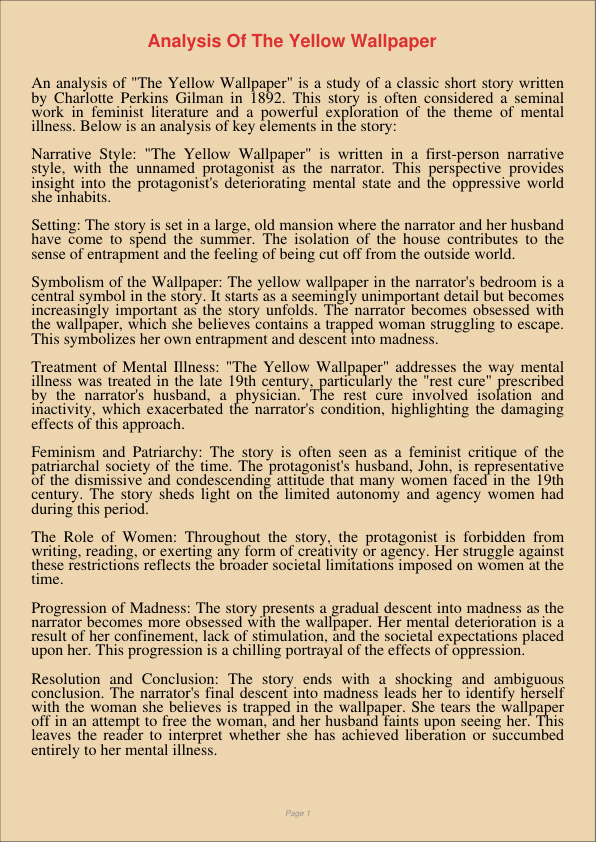Analysis Of The Yellow Wallpaper
Jan 9, 2024
yellow wallpaper
analysis
Information Technology
Human Resources

An analysis of “The Yellow Wallpaper” is a study of a classic short story written by Charlotte Perkins Gilman in 1892. This story is often considered a seminal work in feminist literature and a powerful exploration of the theme of mental illness. Below is an analysis of key elements in the story:
Narrative Style: “The Yellow Wallpaper” is written in a first-person narrative style, with the unnamed protagonist as the narrator. This perspective provides insight into the protagonist’s deteriorating mental state and the oppressive world she inhabits.
Setting: The story is set in a large, old mansion where the narrator and her husband have come to spend the summer. The isolation of the house contributes to the sense of entrapment and the feeling of being cut off from the outside world.
Symbolism of the Wallpaper: The yellow wallpaper in the narrator’s bedroom is a central symbol in the story. It starts as a seemingly unimportant detail but becomes increasingly important as the story unfolds. The narrator becomes obsessed with the wallpaper, which she believes contains a trapped woman struggling to escape. This symbolizes her own entrapment and descent into madness.
Treatment of Mental Illness: “The Yellow Wallpaper” addresses the way mental illness was treated in the late 19th century, particularly the “rest cure” prescribed by the narrator’s husband, a physician. The rest cure involved isolation and inactivity, which exacerbated the narrator’s condition, highlighting the damaging effects of this approach.
Feminism and Patriarchy: The story is often seen as a feminist critique of the patriarchal society of the time. The protagonist’s husband, John, is representative of the dismissive and condescending attitude that many women faced in the 19th century. The story sheds light on the limited autonomy and agency women had during this period.
The Role of Women: Throughout the story, the protagonist is forbidden from writing, reading, or exerting any form of creativity or agency. Her struggle against these restrictions reflects the broader societal limitations imposed on women at the time.
Progression of Madness: The story presents a gradual descent into madness as the narrator becomes more obsessed with the wallpaper. Her mental deterioration is a result of her confinement, lack of stimulation, and the societal expectations placed upon her. This progression is a chilling portrayal of the effects of oppression.
Resolution and Conclusion: The story ends with a shocking and ambiguous conclusion. The narrator’s final descent into madness leads her to identify herself with the woman she believes is trapped in the wallpaper. She tears the wallpaper off in an attempt to free the woman, and her husband faints upon seeing her. This leaves the reader to interpret whether she has achieved liberation or succumbed entirely to her mental illness.
In conclusion, “The Yellow Wallpaper” is a powerful and unsettling exploration of mental illness, the role of women in society, and the damaging effects of patriarchal control. Charlotte Perkins Gilman’s use of symbolism, narrative style, and character development make it a significant work of feminist literature, and it continues to be studied and analyzed for its insights into the human condition and the societal constraints placed on women in the late 19th century.